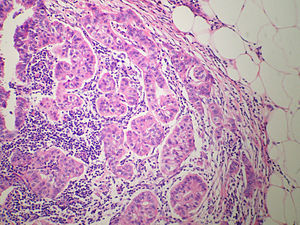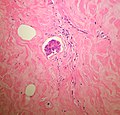Invasive micropapillary carcinoma of the breast
Jump to navigation
Jump to search
The printable version is no longer supported and may have rendering errors. Please update your browser bookmarks and please use the default browser print function instead.
| Invasive micropapillary carcinoma of the breast | |
|---|---|
| Diagnosis in short | |
 Invasive micropapillary carcinoma. H&E stain. | |
|
| |
| LM | small micropapillary tufts of tumour cells or tubuloalveolar structures, central avascular stromal core, lear spaces/clefting around the small clusters of tumor cells, +/-lymphovascular invasion |
| LM DDx | IDC NST with micropapillary features, metastatic serous carcinoma |
| IHC | EMA +ve (periphery of nests) - described as inside-out pattern |
| Grossing notes | breast grossing |
| Staging | breast cancer staging |
| Site | breast - see invasive breast cancer |
|
| |
| Prevalence | rare |
| Prognosis | poor |
| Treatment | surgical excision |
Invasive micropapillary carcinoma of the breast, also micropapillary carcinoma, is a rare type of invasive breast cancer.
General
- Poor prognosis.
- Lymphovascular invasion common.[1]
Microscopic
Features:[2]
- Small micropapillary tufts of tumour cells or tubuloalveolar structures.
- Central avascular stromal core.
- Clear spaces/clefting around the small clusters of tumor cells - diffuse/through-out the tumour - key feature.
- Described as "small clusters of tumour lying within dilated vascular channel-like spaces".[3]
- Can appear sponge like or swiss cheese like.
- Abundant finely granular cytoplasm.
- Mucin cytoplasmic but not in the surrounding clear spaces.
- Nuclear atypia is moderate or severe.
- Mixed(micropapillary + other) histological pattern common.
- Can show psammoma bodies or other calcifications.
DDX
- Invasive mammary carcinoma of no special type with micropapillary features.
- Metastatic papillary serous carcinoma of the ovary (WT1, PAX8 positive).[4]
Note:
- Ductal carcinoma commonly has clefting... but it isn't diffuse.
- Even a minor component of this tumor type should be identified and reported due to the high rate of associated lymphatic invasion and nodal involvement.
- Skin involvement has been reported to be strongly correlated with a poor prognosis for this subtype.
- Micropapillary architectural is retained in node metastases, dermal lymphatic invasion, and recurrences.[5]
Images
www:
- Invasive micropapillary carcinoma (flickr.com/euthman).
- Invasive micropapillary carcinoma - poor quality image (breast-cancer.ca).[6]
IHC
- EMA +ve (periphery of nests); described as inside-out pattern.[3]
- E-cadherin +ve (centre of nests). (???)
- p63 +ve/-ve.
EMA limited to the cytoplasmic membrane oriented toward the stroma. E-cadherin absent on the cytoplasmic membrane oriented toward the stroma. Hypothesized to indicate an inversion of cell polarization and a disturbance in the cell adhesion molecules.[7]
See also
References
- ↑ Yu, JI.; Choi, DH.; Park, W.; Huh, SJ.; Cho, EY.; Lim, YH.; Ahn, JS.; Yang, JH. et al. (Jun 2010). "Differences in prognostic factors and patterns of failure between invasive micropapillary carcinoma and invasive ductal carcinoma of the breast: matched case-control study.". Breast 19 (3): 231-7. doi:10.1016/j.breast.2010.01.020. PMID 20304650.
- ↑ Pettinato, G.; Manivel, CJ.; Panico, L.; Sparano, L.; Petrella, G. (Jun 2004). "Invasive micropapillary carcinoma of the breast: clinicopathologic study of 62 cases of a poorly recognized variant with highly aggressive behavior.". Am J Clin Pathol 121 (6): 857-66. doi:10.1309/XTJ7-VHB4-9UD7-8X60. PMID 15198358.
- ↑ 3.0 3.1 Yamaguchi, R.; Tanaka, M.; Kondo, K.; Yokoyama, T.; Kaneko, Y.; Yamaguchi, M.; Ogata, Y.; Nakashima, O. et al. (Aug 2010). "Characteristic morphology of invasive micropapillary carcinoma of the breast: an immunohistochemical analysis.". Jpn J Clin Oncol 40 (8): 781-7. doi:10.1093/jjco/hyq056. PMID 20444748.
- ↑ Nonaka, D.; Chiriboga, L.; Soslow, RA. (Oct 2008). "Expression of pax8 as a useful marker in distinguishing ovarian carcinomas from mammary carcinomas.". Am J Surg Pathol 32 (10): 1566-71. doi:10.1097/PAS.0b013e31816d71ad. PMID 18724243.
- ↑ Pettinato, G.; Manivel, CJ.; Panico, L.; Sparano, L.; Petrella, G. (Jun 2004). "Invasive micropapillary carcinoma of the breast: clinicopathologic study of 62 cases of a poorly recognized variant with highly aggressive behavior.". Am J Clin Pathol 121 (6): 857-66. doi:10.1309/XTJ7-VHB4-9UD7-8X60. PMID 15198358.
- ↑ URL: http://www.breast-cancer.ca/type/micropapillary-breast-carcinoma.htm. Accessed on: 30 May 2012.
- ↑ Pettinato, G.; Manivel, CJ.; Panico, L.; Sparano, L.; Petrella, G. (Jun 2004). "Invasive micropapillary carcinoma of the breast: clinicopathologic study of 62 cases of a poorly recognized variant with highly aggressive behavior.". Am J Clin Pathol 121 (6): 857-66. doi:10.1309/XTJ7-VHB4-9UD7-8X60. PMID 15198358.

